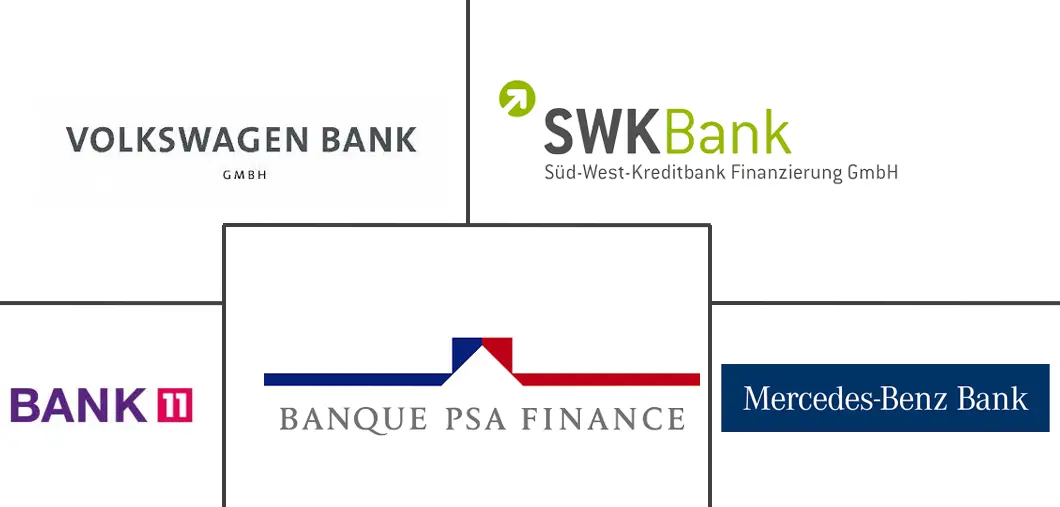Germany Auto Loan Market Size and Share
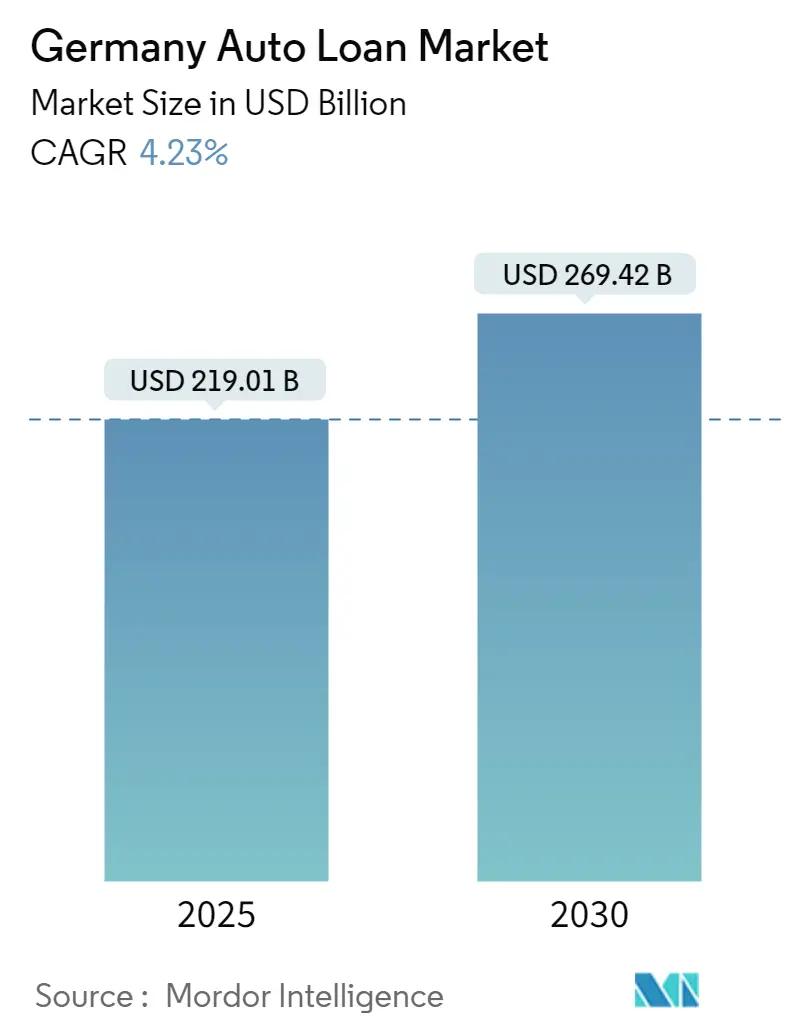
Germany Auto Loan Market Analysis by Mordor Intelligence
The Germany Auto Loan Market size is estimated at USD 219.01 billion in 2025, and is expected to reach USD 269.42 billion by 2030, at a CAGR of 4.23% during the forecast period (2025-2030).
Germany is recognized the world over for its outstanding automotive industry and excellence in engineering. A popular financing option in Germany is the "Ballonfinanzierung," which involves lower monthly payments with a larger final payment (balloon payment) at the end of the term. Leasing is a common alternative to purchasing in Germany. Both individuals and businesses often opt for leasing arrangements, providing flexibility and potential tax benefits. Germany's strong economic stability contributes to a robust automobile finance market, with consumers having the confidence and means to finance vehicle purchases.
The industry has embraced digitalization, and many lenders offer online platforms for convenient loan applications, approvals, and management. The presence of renowned automotive manufacturers in Germany contributes to a thriving automobile finance sector. Affiliation with these brands may influence financing options.
Germany's robust economic stability contributes to a strong auto loan market. Government incentives, particularly for electric vehicles, can impact consumer choices and influence financing options. Incentives may include tax benefits and subsidies. Traditional banks, credit unions, and specialized auto finance companies contribute to a diverse landscape of lenders offering auto loans. Interest rates on auto loans in Germany are competitive and influenced by factors such as the borrower's creditworthiness, loan terms, and prevailing economic conditions.
Germany Auto Loan Market Trends and Insights
New Vehicles Sales are the Major Revenue Generating Segment in Germany
The new vehicle sales segment plays a significant role in generating revenue and influencing the German auto loan market. New vehicle sales contribute directly to the volume and value of auto loans. As consumers purchase new cars, they often seek financing options, leading to increased loan volumes for lenders in the auto finance market. New vehicle loans often come with higher principal amounts compared to used vehicles, impacting lender profitability. The interest income generated from financing new car purchases contributes to the overall revenue for auto loan providers. The demand for new vehicles can influence interest rates and loan terms in the auto loan market. Lenders may adjust interest rates based on factors such as market demand, economic conditions, and the perceived risk associated with financing new cars.
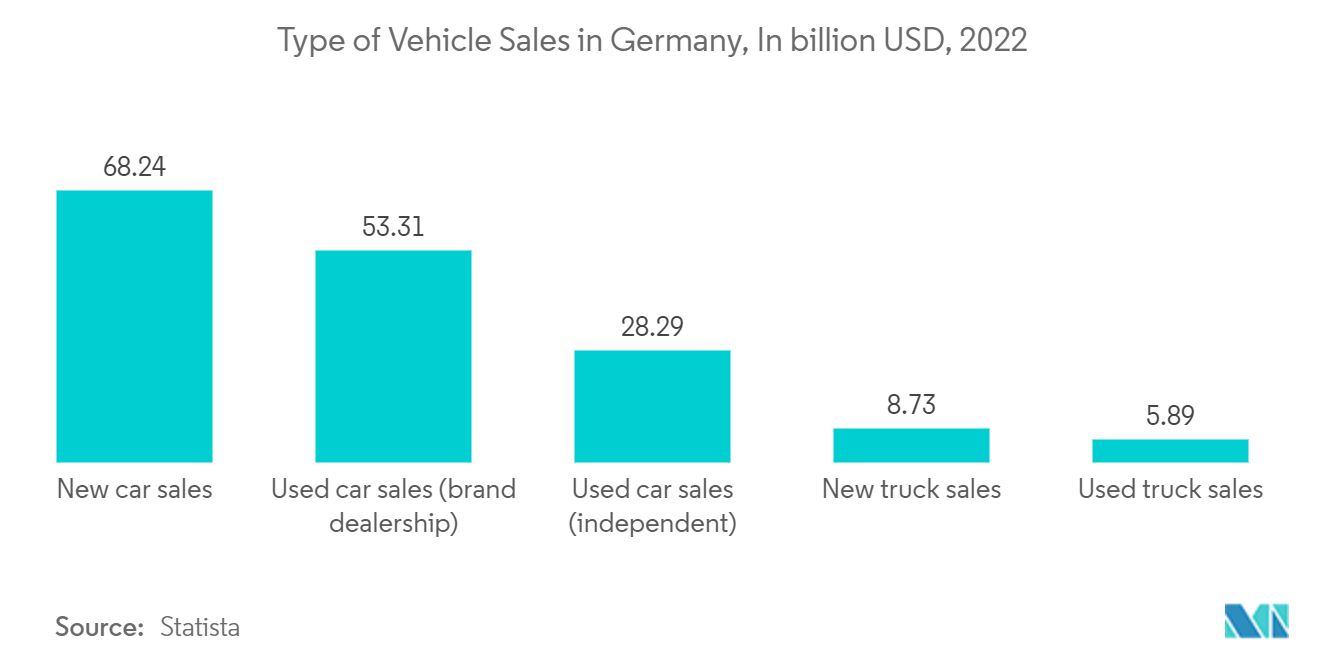
Increasing Registrations of Electric Vehicle in Germany
As more consumers opt for electric vehicles, there may be a shift in demand for auto loans. Consumers may seek financing options specifically tailored to electric cars, considering factors such as the higher upfront cost and potential incentives for electric vehicle purchases. Governments and financial institutions may introduce specific financing incentives or programs to encourage the adoption of electric vehicles. This could include lower interest rates, extended loan terms, or other favorable financing conditions for EV buyers. Consumers may become more aware of the total cost of ownership, considering factors beyond the initial purchase price. Auto loans are influenced by the cost savings associated with electric vehicles, such as lower fuel and maintenance costs.
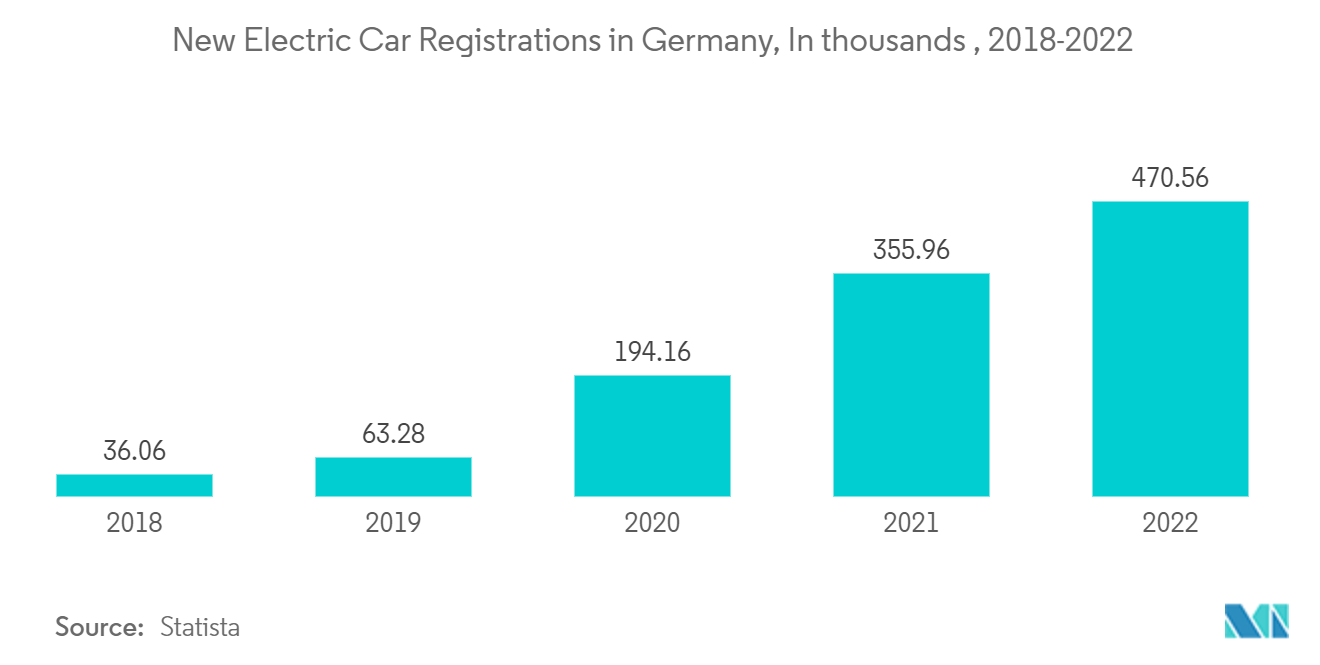
Competitive Landscape
The market for German car loans is relatively fragmented. The key players are emerging to improve their products and delivery through the different loan options and enhancing their products to have a competitive edge over others. Competitiveness in interest rates is a key aspect of the landscape. Lenders strive to offer attractive rates to attract borrowers and gain a competitive edge. The quality of customer service and overall customer experience, including transparency in loan terms, play a crucial role in differentiating lenders in this competitive market. Hence, this section is inclusive of the company profiles of the key players and industry analysis. Auto Loan across Germany is offered by groups such as Volkswagen Bank GmbH, Mercedes-Benz Bank AG, Banque PSA Finance S.A., Bank11 fur Privatkunden und Handel GmbH, Sud-West-Kreditbank Finanzierung GmbH, etc.
Germany Auto Loan Industry Leaders
-
Volkswagen Bank GmbH
-
Mercedes-Benz Bank AG
-
Banque PSA Finance S.A.
-
Bank11 fur Privatkunden und Handel GmbH
-
Sud-West-Kreditbank Finanzierung GmbH
- *Disclaimer: Major Players sorted in no particular order
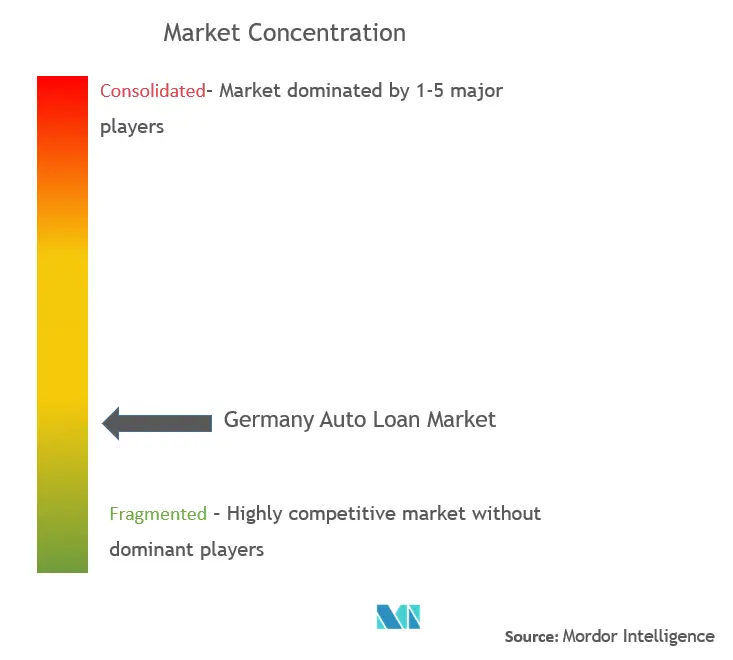
Recent Industry Developments
- September 2023: Europcar Mobility Group and EURO-Leasing GmbH, a fully owned subsidiary of Volkswagen Financial Services AG, announced that Europcar Mobility Group will take a controlling stake of 51% in Euromobil GmbH, the rent-a-car and car subscription business of EURO-Leasing which operates across Volkswagen Group's brands and dealerships in Germany. The other 49% will remain with EURO-Leasing GmbH.
- April 2023: SWK Bank, one of Germany's leading service and direct banks, is expected to move from its current headquarters in Bingen to Mainz. The new office space in Mainz was specifically designed to promote collaboration between teams and individual areas and thus support the bank's further growth.
Germany Auto Loan Market Report Scope
An auto loan is a segment of the loan category offered by banks and financial service providers to automobile buyers over a given period with an agreed interest rate and installment amount. Mostly, the loan is taken for two segments of automobiles, which consist of passenger and commercial vehicles.
The study gives a brief description of the German auto loan market and includes details on interest rates, type of loans offered, and auto loan products & services. Germany's auto loan market is segmented by product, ownership, provider type, and tenure. By Product, the market is segmented into passenger vehicles and commercial vehicles. By ownership, the market is segmented by new vehicles and used vehicles. By provider type, the market is segmented by banks, nonbanking financial companies, original equipment manufacturers, credit unions, and others. Others include fintech companies. By tenure, the market is segmented into less than three years, 3-5 years, and more than 5 years.
The report offers market size and forecasts for the German auto loan market in value (USD) for all the above segments.
| Passenger Vehicle |
| Commercial Vehicle |
| New Vehicles |
| Used Vehicles |
| Banks |
| Non Banking Financials Companies |
| Original Equiptment Manufacturers |
| Credit Unions |
| Other Provider Types |
| Less than Three Years |
| 3-5 Years |
| More Than 5 Years |
| By Vehicle Type | Passenger Vehicle |
| Commercial Vehicle | |
| By Ownership | New Vehicles |
| Used Vehicles | |
| By Provider Type | Banks |
| Non Banking Financials Companies | |
| Original Equiptment Manufacturers | |
| Credit Unions | |
| Other Provider Types | |
| By Tenure | Less than Three Years |
| 3-5 Years | |
| More Than 5 Years |
Key Questions Answered in the Report
How big is the Germany Auto Loan Market?
The Germany Auto Loan Market size is expected to reach USD 219.01 billion in 2025 and grow at a CAGR of 4.23% to reach USD 269.42 billion by 2030.
What is the current Germany Auto Loan Market size?
In 2025, the Germany Auto Loan Market size is expected to reach USD 219.01 billion.
Who are the key players in Germany Auto Loan Market?
Volkswagen Bank GmbH, Mercedes-Benz Bank AG, Banque PSA Finance S.A., Bank11 fur Privatkunden und Handel GmbH and Sud-West-Kreditbank Finanzierung GmbH are the major companies operating in the Germany Auto Loan Market.
What years does this Germany Auto Loan Market cover, and what was the market size in 2024?
In 2024, the Germany Auto Loan Market size was estimated at USD 209.75 billion. The report covers the Germany Auto Loan Market historical market size for years: 2020, 2021, 2022, 2023 and 2024. The report also forecasts the Germany Auto Loan Market size for years: 2025, 2026, 2027, 2028, 2029 and 2030.
Page last updated on:
Germany Auto Loan Market Report
Statistics for the 2025 Germany Auto Loan market share, size and revenue growth rate, created by Mordor Intelligence™ Industry Reports. Germany Auto Loan analysis includes a market forecast outlook for 2025 to 2030 and historical overview. Get a sample of this industry analysis as a free report PDF download.
